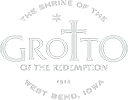Agate
Agate is chalcedony with a banded or irregular, variegated appearance. Many excellent specimens of agate can be found in the Christmas Chapel, Stations of the Cross and the exterior of the Museum and Rock Studio buildings.
Amethyst
Quartz with clear purple or violet color. A 300-pound amethyst is incorporated into the back wall of the Christmas Chapel. Specimens used within the Grotto are from Brazil and from the Andes mountains in South America.
Azurite & Malachite
Malachite and Azurite are usually found together in copper mines in the Southwest. Malachite is green and Azurite is blue. While both Malachite and Azurite can be seen throughout the Grotto, a couple of areas where large quantities were used include the ‘sky’ in the Christmas Chapel and the Sermon on the Mount where gold mosaic tiles were inlaid in copper ore.
Barite & Barite Rose
Barite is a fairly soft but heavy mineral in shades of red, brown, gray, yellow and white. The Barite Rose, Oklahoma’s state rock, is shaped like a rose and is found in the US almost exclusively in Oklahoma. The Garden of Gethsemane has some excellent specimens of Barite.
Drusy Quartz
Drusy crystals are aggregates of small, well-formed crystals that grow on the surface of a rock or along fractures in rocks. Crust of small crystals.
Calcite
Dogtooth Spar and Stalactites and Stalagmites are some varies of calcite that can be found in the Grotto. The ‘snow capped’ mountains and peaks are Dogtooth Spar which came primarily from Joplin, MO. A 2200 pound stalagmite originating from the Carlsbad caverns is near the top of the Sermon on the Mount flanked by petrified wood.
Fluorite
Found primarily in Southern Illinois, Fluorite comes in varied colors of violet, blue, white and green and clear. Fluorite crystals form in a cubic system similar to clusters of sugar cubes.
Geode
Iowa’s state rock.
Jasper
Jasper is an opaque quartz usually red, yellow or brown, or a mixture of these colors. The pillars in the Stations of the Cross are made from reddish-brown Jasper from Michigan.
Petrified Wood
Over millions of years, a buried tree, root or plant is replaced with minerals in the surrounding soil. Specimens used within the Grotto came primarily from Montana and North Dakota and can be identified by their coloration of gray, tan and browns. Special dispensation to remove a petrified log from a National Forest in Arizona was granted in the 1950’s. Crosscut sections of this log can be found at the top of the 13th Station directly under the cross, and incorporated into the Stable of Bethlehem.
Quartz
Much of the clear Crystalline Quartz found in the Grotto came from Mt. Ida, Arkansas. Most of the rosettes Fr. Dobberstein assembled contain a variety of Crystalline Quartz- Rose Quartz, Amethyst, Smoky or Clear Quartz.
Shrine of the Grotto

© 2024 The Shrine of the Grotto of the Redemption | West Bend, Iowa. Website Development by Neapolitan Labs

